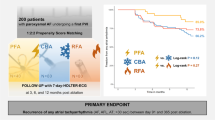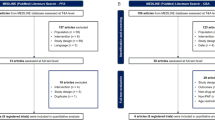Abstract
Background
Catheter ablation is proven to be an effective strategy for drug refractory ventricular tachycardia (VT) in ischemic cardiomyopathy. However, the appropriate timing of VT ablation and identifying the group of patients that may receive the greatest benefit remains uncertain. There is limited data on the effect on prophylactic catheter ablation (PCA) in the prevention of implantable cardioverter defibrillator (ICD) therapy, electrical storm, and mortality.
Methods
We performed a comprehensive literature search through November 1, 2017, for all eligible studies comparing PCA + ICD versus ICD only in eligible patients with ischemic cardiomyopathy. Clinical outcomes included all ICD therapies including ICD shocks and electrical storm. Additional outcomes included all-cause mortality, cardiovascular mortality, and complications.
Results
Three randomized controlled trials (RCTs) (N = 346) met inclusion criteria. PCA was associated with a significantly lower ICD therapies (OR 0.49; CI 0.28 to 0.87; p = 0.01) including ICD shocks [OR 0.38; CI 0.22 to 0.64; p = 0.0003) and electrical storm (OR 0.55; CI 0.30 to 1.01; p = 0.05) when compared with ICD only. There was no significant difference in all-cause mortality (OR 0.77; CI 0.41 to 1.46; p = 0.42), cardiovascular mortality (OR 0.49; CI 0.16 to 1.50; p = 0.21), and major adverse events (OR 1.45; CI 0.52 to 4.01; p = 0.47) between two groups.
Conclusion
These results suggest prophylactic catheter ablation decreases ICD therapies, including shocks and electrical storm with no improvement in overall mortality. There is a need for future carefully designed randomized clinical trials.





Similar content being viewed by others
Abbreviations
- PCA:
-
Prophylactic catheter ablation
- ICD:
-
Implantable cardiac defibrillator
- AAD:
-
Anti-arrhythmic drugs
- RCT:
-
Randomized controlled trial
References
Koplan BA, Stevenson WG. Ventricular tachycardia and sudden cardiac death. Mayo Clin Proc. 2009;84(3):289–97.
MacIntyre CJ, Sapp JL. Treatment of persistent ventricular tachycardia: drugs or ablation? Trends Cardiovasc Med. 2017;27(7):506–13.
Dunbar SB, Dougherty CM, Sears SF, et al. Educational and psychological interventions to improve outcomes for recipients of implantable cardioverter defibrillators and their families: a scientific statement from the American Heart Association. Circulation. 2012;126(17):2146–72.
Antiarrhythmics versus Implantable Defibrillators (AVID) Investigators. A comparison of antiarrhythmic-drug therapy with implantable defibrillators in patients resuscitated from near-fatal ventricular arrhythmias. N Engl J Med. 1997;337(22):1576–83.
Moss AJ, Zareba W, Hall WJ, et al. Prophylactic implantation of a defibrillator in patients with myocardial infarction and reduced ejection fraction. N Engl J Med. 2002;346(12):877–83.
Daubert JP, Zareba W, Cannom DS, et al. Inappropriate implantable cardioverter-defibrillator shocks in MADIT II: frequency, mechanisms, predictors, and survival impact. J Am Coll Cardiol. 2008;51(14):1357–65.
Poole JE, Johnson GW, Hellkamp AS, et al. Prognostic importance of defibrillator shocks in patients with heart failure. N Engl J Med. 2008;359(10):1009–17.
Connolly SJ, Dorian P, Roberts RS, et al. Comparison of beta-blockers, amiodarone plus beta-blockers, or sotalol for prevention of shocks from implantable cardioverter defibrillators: the OPTIC study: a randomized trial. JAMA. 2006;295(2):165–71.
Aliot EM, Stevenson WG, Almendral-Garrote JM, et al. EHRA/HRS expert consensus on catheter ablation of ventricular arrhythmias: developed in a partnership with the European Heart Rhythm Association (EHRA), a registered branch of the European Society of Cardiology (ESC), and the Heart Rhythm Society (HRS); in collaboration with the American College of Cardiology (ACC) and the American Heart Association (AHA). Europace. 2009;11(6):771–817.
Pedersen CT, Kay GN, Kalman J, et al. EHRA/HRS/APHRS expert consensus on ventricular arrhythmias. Heart Rhythm. 2014;11(10):e166-e196.
Liang JJ, Santangeli P, Callans DJ. Long-term outcomes of ventricular tachycardia ablation in different types of structural heart disease. Arrhythm Electrophysiol Rev. 2015;4(3):177–83.
Dinov B, Arya A, Bertagnolli L, Schirripa - Circulation: … V, 2014. Early referral for ablation of scar-related ventricular tachycardia is associated with improved acute and long term outcomes: results from the heart center of …. Am Heart Assoc. 2014. http://circep.ahajournals.org/content/early/2014/09/27/CIRCEP.114.001953.short.
Frankel DS, Mountantonakis SE, Robinson MR, Zado ES, Callans DJ, Marchlinski FE. Ventricular tachycardia ablation remains treatment of last resort in structural heart disease: argument for earlier intervention. J Cardiovasc Electrophysiol. 2011;22(10):1123–8.
Romero J, Di Biase L, Diaz JC, et al. Early versus late referral for catheter ablation of ventricular tachycardia in patients with structural heart disease: a systematic review and meta-analysis of clinical outcomes. JACC: Clin Electrophysiol. 2018;4(3):374–82.
Mukherjee RK, O’Neill L, O’Neill MD. Prophylactic catheter ablation for ventricular tachycardia: are we there yet? Arrhythm Electrophysiol Rev. 2017;6(3):125–8.
Reddy VY, Reynolds MR, Neuzil P, et al. Prophylactic catheter ablation for the prevention of defibrillator therapy. N Engl J Med. 2007;357(26):2657–65.
Kuck K-H, Schaumann A, Eckardt L, et al. Catheter ablation of stable ventricular tachycardia before defibrillator implantation in patients with coronary heart disease (VTACH): a multicentre randomised controlled trial. Lancet. 2010;375(9708):31–40.
Kuck K-H, Tilz RR, Deneke T, et al. Impact of substrate modification by catheter ablation on implantable cardioverter-defibrillator interventions in patients with unstable ventricular arrhythmias and coronary artery disease: results from the multicenter randomized controlled SMS (substrate modification study). Circ Arrhythm Electrophysiol. 2017;10(3) https://doi.org/10.1161/CIRCEP.116.004422.
Pokorney SD, Friedman DJ, Calkins H, et al. Catheter ablation of ventricular tachycardia: lessons learned from past clinical trials and implications for future clinical trials. Heart Rhythm. 2016;13(8):1748–54.
Moher D, Liberati A, Tetzlaff J, Altman DG. PRISMA group. Preferred reporting items for systematic reviews and meta-analyses: the PRISMA statement. Ann Intern Med. 2009;151(4):264–9. W64
DerSimonian R, Laird N. Meta-analysis in clinical trials. Control Clin Trials. 1986;7(3):177–88.
Higgins JPT, Altman DG, Gøtzsche PC, et al. The Cochrane Collaboration’s tool for assessing risk of bias in randomised trials. BMJ. 2011;343:d5928.
Go AS, Mozaffarian D, Roger VL, et al. Heart disease and stroke statistics—2014 update: a report from the American Heart Association. Circulation. 2014;129(3):e28–e292.
Lo R, Chia KKM, Hsia HH. Ventricular tachycardia in ischemic heart disease. Card Electrophysiol Clin. 2017;9(1):25–46.
de Bakker JMT, van Capflle FJL, Janse MJ, et al. Macroreentry in the infarcted human heart: the mechanism of ventricular tachycardias with a “focal” activation pattern. J Am Coll Cardiol. 1991;18(4):1005–14.
Palaniswamy C, Kolte D, Harikrishnan P, et al. Catheter ablation of postinfarction ventricular tachycardia: ten-year trends in utilization, in-hospital complications, and in-hospital mortality in the United States. Heart Rhythm. 2014;11(11):2056–63.
Haqqani HM, Roberts-Thomson KC. Radiofrequency catheter ablation for ventricular tachycardia. Heart Lung Circ. 2012;21(6-7):402–12.
Liang JJ, Muser D, Santangeli P. Ventricular tachycardia ablation clinical trials. Card Electrophysiol Clin. 2017;9(1):153–65.
Tung R, Vaseghi M, Frankel DS, et al. Freedom from recurrent ventricular tachycardia after catheter ablation is associated with improved survival in patients with structural heart disease: an International VT Ablation Center Collaborative Group study. Heart Rhythm. 2015;12(9):1997–2007.
Sapp JL, Wells GA, Parkash R, et al. Ventricular tachycardia ablation versus escalation of antiarrhythmic drugs. N Engl J Med. 2016;375(2):111–21.
Suzuki A, Yoshida A, Takei A, et al. Prophylactic catheter ablation of ventricular tachycardia before cardioverter-defibrillator implantation in patients with non-ischemic cardiomyopathy: clinical outcomes after a single endocardial ablation. J Arrhythm. 2015;31(3):122–9.
Irvine J, Dorian P, Baker B, et al. Quality of life in the Canadian implantable defibrillator study (CIDS). Am Heart J. 2002;144(2):282–9.
Soejima K, Suzuki M, Maisel WH, et al. Catheter ablation in patients with multiple and unstable ventricular tachycardias after myocardial infarction: short ablation lines guided by reentry circuit isthmuses and sinus rhythm mapping. Circulation. 2001;104(6):664–9.
Marchlinski FE, Callans DJ, Gottlieb CD, Zado E. Linear ablation lesions for control of unmappable ventricular tachycardia in patients with ischemic and nonischemic cardiomyopathy. Circulation. 2000;101(11):1288–96.
Tung R, Josephson ME, Reddy V, Reynolds MR, SMASH-VT Investigators. Influence of clinical and procedural predictors on ventricular tachycardia ablation outcomes: an analysis from the substrate mapping and ablation in Sinus Rhythm to Halt Ventricular Tachycardia Trial (SMASH-VT). J Cardiovasc Electrophysiol. 2010;21(7):799–803.
Muser D, Liang JJ, Pathak RK, et al. Long-term outcomes of catheter ablation of electrical storm in nonischemic dilated cardiomyopathy compared with ischemic cardiomyopathy. JACC: Clin Electrophysiol. 2017;3(7):767–78.
Di Biase L, Burkhardt JD, Lakkireddy D, et al. Ablation of stable VTs versus substrate ablation in ischemic cardiomyopathy: the VISTA randomized multicenter trial. J Am Coll Cardiol. 2015;66(25):2872–82.
Silberbauer J, Oloriz T, Maccabelli G, et al. Noninducibility and late potential abolition: a novel combined prognostic procedural end point for catheter ablation of postinfarction ventricular tachycardia. Circ Arrhythm Electrophysiol. 2014;7(3):424–35.
Mizuno H. Mapping of ventricular tachycardia in patients with structural heart disease. J Arrhythmia. 2014;30(4):283–91.
Yoshiga Y, Mathew S, Wissner E, et al. Correlation between substrate location and ablation strategy in patients with ventricular tachycardia late after myocardial infarction. Heart Rhythm. 2012;9(8):1192–9.
Sacher F, Roberts-Thomson K, Maury P, et al. Epicardial ventricular tachycardia ablation a multicenter safety study. J Am Coll Cardiol. 2010;55(21):2366–72.
Di Biase L, Santangeli P, Burkhardt DJ, et al. Endo-epicardial homogenization of the scar versus limited substrate ablation for the treatment of electrical storms in patients with ischemic cardiomyopathy. J Am Coll Cardiol. 2012;60(2):132–41.
Santangeli P, Muser D, Maeda S, et al. Comparative effectiveness of antiarrhythmic drugs and catheter ablation for the prevention of recurrent ventricular tachycardia in patients with implantable cardioverter-defibrillators: a systematic review and meta-analysis of randomized controlled trials. Heart Rhythm. 2016;13(7):1552–9.
Carbucicchio C, Santamaria M, Trevisi N, et al. Catheter ablation for the treatment of electrical storm in patients with implantable cardioverter-defibrillators. Circulation. 2008;117(4):462–9.
Sesselberg HW, Moss AJ, McNitt S, et al. Ventricular arrhythmia storms in postinfarction patients with implantable defibrillators for primary prevention indications: a MADIT-II substudy. Heart Rhythm. 2007;4(11):1395–402.
Winterfield JR, Kent AR, Karst E, et al. Impact of ventricular tachycardia ablation on health care utilization. Heart Rhythm. 2017; https://doi.org/10.1016/j.hrthm.2017.10.009.
Preventive aBlation of vEntricular tachycaRdia in Patients With myocardiaL INfarction - Full Text View - ClinicalTrials.gov. https://clinicaltrials.gov/ct2/show/NCT02501005. Accessed 26 Nov 2017.
Does Timing of VT Ablation Affect Prognosis in Patients With an Implantable Cardioverter-defibrillator? - Full Text View - ClinicalTrials.gov. https://clinicaltrials.gov/ct2/show/NCT01547208. Accessed 26 Nov 2017.
Author information
Authors and Affiliations
Corresponding author
Ethics declarations
Conflict of interest
The authors declare that they have no conflict of interest.
Ethical approval
The manuscript has not been submitted or is under consideration elsewhere in any other journal. No data has been fabricated or manipulated. Consent to submit has been received explicitly from all co-authors.
Electronic supplementary material
ESM 1
(DOCX 27 kb)
Rights and permissions
About this article
Cite this article
Atti, V., Vuddanda, V., Turagam, M.K. et al. Prophylactic catheter ablation of ventricular tachycardia in ischemic cardiomyopathy: a systematic review and meta-analysis of randomized controlled trials. J Interv Card Electrophysiol 53, 207–215 (2018). https://doi.org/10.1007/s10840-018-0376-5
Received:
Accepted:
Published:
Issue Date:
DOI: https://doi.org/10.1007/s10840-018-0376-5




